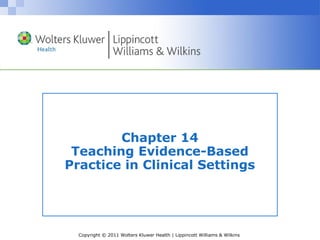
Chapter014
- 1. Copyright © 2011 Wolters Kluwer Health | Lippincott Williams & Wilkins Chapter 14 Teaching Evidence-Based Practice in Clinical Settings
- 2. Copyright © 2011 Wolters Kluwer Health | Lippincott Williams & Wilkins The Need for Teaching EBP in Clinical Settings • Changes in practice have often been mandated to clinicians versus being generated by clinicians • There has been little consideration of the basic paradigm from which clinicians practice • Regulatory and accrediting agencies have indicated that organizations that are practicing based on evidence will reap rewards • EBP makes sense from a safety perspective and from a best care perspective
- 3. Copyright © 2011 Wolters Kluwer Health | Lippincott Williams & Wilkins Challenges in the Clinical Setting • A commonly-cited barrier is the skill level of the individual nurse − Related to nurse education level and demographics − Many nurses received no teaching about EBP during nursing school • Many nurses have difficulty interpreting and applying study findings • Librarians are rarely consulted
- 4. Copyright © 2011 Wolters Kluwer Health | Lippincott Williams & Wilkins Challenges in the Clinical Setting (cont’d) • Stressors related to shortages in the RN workforce and the demands of long shifts and increased patient loads • Lack of time • Nurses report that managers do not account for the limitations of the practice setting for application of EBP • Competing organizational priorities The crux of teaching nurses and other healthcare providers about EBP is buy-in
- 5. Copyright © 2011 Wolters Kluwer Health | Lippincott Williams & Wilkins Question • Tell whether the following statement is true or false. • Providing nurses with adequate time and education will result in the implementation of EBP in a practice setting.
- 6. Copyright © 2011 Wolters Kluwer Health | Lippincott Williams & Wilkins Answer • False • Rationale: Numerous barriers and challenges can complicate or impede the implementation of EBP in practice settings. Providing nurses with the time and knowledge to implement EBP is necessary, but these measures alone are unlikely to result in a fundamental change in practice.
- 7. Copyright © 2011 Wolters Kluwer Health | Lippincott Williams & Wilkins Organizational Readiness for Teaching Evidence-Based Practice • The organization must commit to provide the resources and leadership necessary to transform the culture to one that demonstrates EBP daily − Transformational leadership • Shared governance can foster mutual goals − An EBP or Research/EBP Council can address clinical issues with evidence − A Practice Council can take evidence compiled and synthesized by the EBP Council and operationalize it
- 8. Copyright © 2011 Wolters Kluwer Health | Lippincott Williams & Wilkins Question • A hospital’s EBP Council is collaborating with nurses in light of a recent clinical controversy. Which of the following roles should the council primarily perform? a. Teaching nurses about the mandate for basing practice on evidence b. Performing valid and reliable research to answer the clinical question c. Utilizing existing research to inform a potential change in practice d. Eliciting patient preferences to combine with clinical expertise and research evidence
- 9. Copyright © 2011 Wolters Kluwer Health | Lippincott Williams & Wilkins Answer • c. Utilizing existing research to inform a potential change in practice • Rationale: The central role of an EBP Council is to address clinical issues with evidence. At times, the council may choose to educate nurses about EBP or elicit patient preferences, but the main function is to mobilize evidence. EBP Councils are unlikely to perform original research.
- 10. Copyright © 2011 Wolters Kluwer Health | Lippincott Williams & Wilkins Essential Resources for Teaching EBP • Begin with assessment of the resources that are available or could be dedicated to EBP − Emphasis on human resources − Numerous tutorials and courses are available • Assess individuals’ computer and informatics literacy • Ensure that you have a clinical or medical librarian on the teaching team − Electronic access to evidence is vital • Financial support
- 11. Copyright © 2011 Wolters Kluwer Health | Lippincott Williams & Wilkins Strategies for Teaching Evidence-Based Practice • Begin by engaging leaders, unit educators, and advanced practice nurses − Support from managers is vital • Once a team of educators and EBP mentors has been developed, begin to educate bedside caregivers − EBP education via seminars, self-directed learning, journal clubs, committee structure − Computer education • Teaching EBP in the clinical setting also can be enhanced through partnerships with academic institutions
- 12. Copyright © 2011 Wolters Kluwer Health | Lippincott Williams & Wilkins Question • A hospital unit has an identified need to increase caregivers’ familiarity and skills surrounding evidence- based practice. An educational initiative to address this deficit should focus first on whom? a. The most experienced nurses on the unit b. The manager of the unit c. Academic experts from a local university d. The hospital’s medical librarian
- 13. Copyright © 2011 Wolters Kluwer Health | Lippincott Williams & Wilkins Answer • b. The manager of the unit • Rationale: It is important to engage managers, unit educators, and advanced practice nurses at the outset of EBP education because these individuals serve as models of change for point-of-care staff. Staff nurses, librarians, and academic experts may be consulted after engaging these leaders.
- 14. Copyright © 2011 Wolters Kluwer Health | Lippincott Williams & Wilkins Summary • Teaching EBP is a continuous process that will result in improved patient care outcomes, professional growth, and an empowered clinical staff • It is not accomplished through one program, one committee, or one project • Teaching EBP in a clinical setting requires commitment, diligence, enthusiasm, creativity, and team work